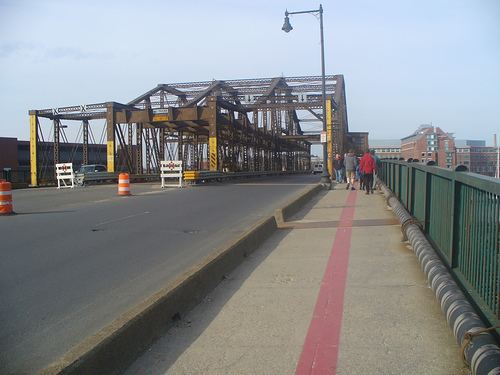Maintained by City of Boston Opened 1900 Phone +1 617-241-8500 | Locale Boston, Massachusetts Construction started 1898 Total length 332 m | |
 | ||
Carries North Washington Street Address 1 Thompson Sq # 107, Charlestown, MA 02129, USA Similar Charles River Dam, Leonard P Zakim Bunker Hi, Tobin Bridge, Longfellow Bridge, Leverett Circle Connecto | ||
The music of rubber on the charlestown bridge
The Charlestown Bridge (also called the North Washington Street Bridge) is located in Boston and spans the Charles River. As the river's easternmost crossing, the bridge connects the neighborhoods of Charlestown and the North End. Completed in 1900, the bridge carries a portion of the Freedom Trail linking to the USS Constitution and Bunker Hill. To the north, the Charlestown bridge connects to Rutherford Avenue; to the south it connects with North Washington Street. (With the pending renovation of the bridge anticipated to start in Autumn 2017, there has been discussion of changing the name of the bridge to the Cornelius F. Regan or Regan Bridge. This is in honor of patrolman Cornelius F. Regan, who was killed in the line of duty 1/13/1898. He died of injuries sustained while saving someone from drowning who jumped off the bridge into the Charles River.)
Contents
- The music of rubber on the charlestown bridge
- Charlestown bridge over the charles river designed by miguel rosales and benesch engineers
- History
- References
Charlestown bridge over the charles river designed by miguel rosales and benesch engineers
History
The first government-sanctioned ferry crossing of the Charles was chartered at this location in the 1630s. It was operated by various individuals until it was given to Harvard College "in perpetuity" in 1640, to support the college financially. In 1640, the Massachusetts General Court granted Harvard College the revenue from the Boston-Charlestown ferry to help support the institution. The Harvard Corporation in its capacity managed the Charlestown ferry from the 1640s until 1785, and after the completion of the Charles River Bridge in 1785.
The first bridge on this site was known as the Charles River Bridge, chartered in 1785 and opened on June 17, 1786. As a condition of chartering the bridge, a sum of £200 was paid annually to Harvard College to compensate for the lost ferry income. The bridge was privately built and operated, with tolls producing profits for the investors during the charter period, after the initial expense was paid off. In 1792, the West Boston Bridge was chartered, connecting West Boston to Cambridge. In compensation, the legislature extended the charter period of the Charles River Bridge by 30 years, but the unpopular double tolls on Sundays were eliminated. Traffic to the bridge was facilitated by the laying out of the Medford Turnpike in 1803.
When the Warren Bridge was chartered in 1828 in a location extremely close to the Charles River Bridge, the investors filed a lawsuit which eventually reached the United States Supreme Court as Charles River Bridge v. Warren Bridge.
The current bridge was built in 1900 under chief engineer William Jackson, and was designed to carry the Charlestown Elevated railway in addition to vehicle traffic. However, the railway was demolished in 1975 to make way for its replacement, the MBTA Orange Line. The new line was rerouted to avoid having to pass directly through the densely populated Charlestown neighborhood. The Haymarket Tunnel was inaugurated in 1975 as the designated tunnel for Orange Line trains. Because the bridge was originally designed to accommodate an elevated railroad in addition to automobiles, the bridge spans six lanes.
The bridge formerly carried the southernmost stretch of Massachusetts Route 99 to its terminus at the river, but following completion of the Big Dig in the late 2000s its designation was changed to terminate before the crossing. Route 99 now ends a few blocks up at Chelsea Street in Charlestown instead.
The Charlestown Bridge is scheduled to be replaced over a 3–4 year construction period starting in 2017. The replacement bridge, designed by architect Miguel Rosales in collaboration with Alfred Benesch & Co. who are the design and consulting engineers, will consist of two lanes in each direction and will feature a design complementary to the Zakim Bridge (with which Rosales was also involved).
